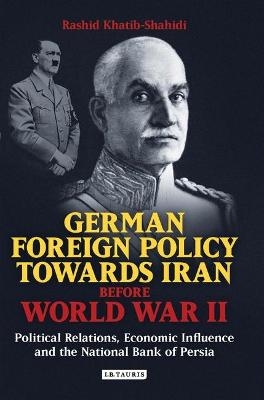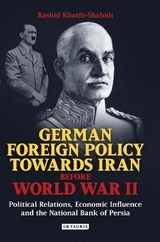German Foreign Policy Towards Iran Before World War II
Political Relations, Economic Influence and the National Bank of Persia
Seiten
By World War II, Reza Shah's Iran and Hitler's Germany had developed close commercial ties. But this was a relationship that came to an abrupt end with the Allied invasion of Iran in 1941.
Early twentieth-century Iran had been dominated by the competing influences of the two great imperial powers of the time - Russia and Britain - making it difficult for a third power to establish a foothold. But an emergent, highly industrialised and assertive Germany in the 1930s became an attractive ally through which Iran could cut loose from domination by Britain and the Soviet Union, allowing it to seek modernity outside the constraints of old imperial interests. This led to the development of close commercial ties between Reza Shah's Persia and Hitler's Germany in the interwar period, an aspect of German foreign policy that is often overlooked. It was the National Bank of Persia, established in 1927 under German management, and with Kurt Lindenblatt as its governor, that was to be the vehicle for Germany's commercial expansion into Iran. The Bank was a vital engine driving industrialisation, even after Lindenblatt retired and was followed by Gholam Reza Amir-Khosrari and a board of directors including Hossein Ala and Abdul Hossein Hazhir.
By the mid-1930s, a new German foreign policy approach of active diplomacy fortified initial inroads into the Iranian economy, building upon the foundations laid by individual entrepreneurs, the National Bank and the construction of the Trans-Iranian Railway. Iran evolved into an attractive country for international trade and, at the outbreak of World War II, Germany was Iran's largest trading partner - surpassing both the Soviet Union and Britain. These close ties reveal a complex relationship between Germany and Iran, and an admiration of the Nazi's brand of industrial, scientific and organisational progress. It was, however, a relationship that came to an abrupt end with the Allied invasion of Iran in 1941 that deposed the Shah. Khatib-Shahidi delves into previously untapped German primary sources to explore the nature of German involvement in Iran between the wars, examining how it came to be moulded by a handful of individuals. This book is a revealing resource on the historical ties between Iran and Germany, making it indispensable for students and researchers of European Imperialism and Colonialism in the Middle East as well as of Iranian Political and Economic History.
Early twentieth-century Iran had been dominated by the competing influences of the two great imperial powers of the time - Russia and Britain - making it difficult for a third power to establish a foothold. But an emergent, highly industrialised and assertive Germany in the 1930s became an attractive ally through which Iran could cut loose from domination by Britain and the Soviet Union, allowing it to seek modernity outside the constraints of old imperial interests. This led to the development of close commercial ties between Reza Shah's Persia and Hitler's Germany in the interwar period, an aspect of German foreign policy that is often overlooked. It was the National Bank of Persia, established in 1927 under German management, and with Kurt Lindenblatt as its governor, that was to be the vehicle for Germany's commercial expansion into Iran. The Bank was a vital engine driving industrialisation, even after Lindenblatt retired and was followed by Gholam Reza Amir-Khosrari and a board of directors including Hossein Ala and Abdul Hossein Hazhir.
By the mid-1930s, a new German foreign policy approach of active diplomacy fortified initial inroads into the Iranian economy, building upon the foundations laid by individual entrepreneurs, the National Bank and the construction of the Trans-Iranian Railway. Iran evolved into an attractive country for international trade and, at the outbreak of World War II, Germany was Iran's largest trading partner - surpassing both the Soviet Union and Britain. These close ties reveal a complex relationship between Germany and Iran, and an admiration of the Nazi's brand of industrial, scientific and organisational progress. It was, however, a relationship that came to an abrupt end with the Allied invasion of Iran in 1941 that deposed the Shah. Khatib-Shahidi delves into previously untapped German primary sources to explore the nature of German involvement in Iran between the wars, examining how it came to be moulded by a handful of individuals. This book is a revealing resource on the historical ties between Iran and Germany, making it indispensable for students and researchers of European Imperialism and Colonialism in the Middle East as well as of Iranian Political and Economic History.
Rashid Khatib-Shahidi holds a DPhil from the University of Oxford.
Introduction
Chapter 1: Persia, the International Environment, and the German Economic Approach
Chapter 2: German Foreign Policy Towards Persia
Chapter 3: German Foreign and Economic Relations in Persia: Their Evolution and the Role of the National Bank
Chapter 4: Challenges for German Foreign Policy towards Persia and the National Bank
Chapter 5: The National Bank Controversy and the End of the Taimurtash Era
Chapter 6: The Lindenblatt Affair and the National Bank
Chapter 7: Germany’s Political Relations Advance Economic Influence in Persia
Chapter 8: Conclusion
Notes
Bibliography
Index
| Sprache | englisch |
|---|---|
| Maße | 138 x 216 mm |
| Gewicht | 432 g |
| Themenwelt | Geschichte ► Allgemeine Geschichte ► Neuzeit (bis 1918) |
| Geschichte ► Allgemeine Geschichte ► 1918 bis 1945 | |
| Geisteswissenschaften ► Geschichte ► Regional- / Ländergeschichte | |
| Sozialwissenschaften ► Politik / Verwaltung ► Europäische / Internationale Politik | |
| ISBN-10 | 1-84885-324-6 / 1848853246 |
| ISBN-13 | 978-1-84885-324-9 / 9781848853249 |
| Zustand | Neuware |
| Informationen gemäß Produktsicherheitsverordnung (GPSR) | |
| Haben Sie eine Frage zum Produkt? |
Mehr entdecken
aus dem Bereich
aus dem Bereich
Giordano Bruno - ein ketzerisches Leben
Buch | Hardcover (2024)
C.H.Beck (Verlag)
CHF 41,85
das dramatische 16. Jahrhundert
Buch | Hardcover (2024)
Rowohlt Berlin (Verlag)
CHF 47,60




